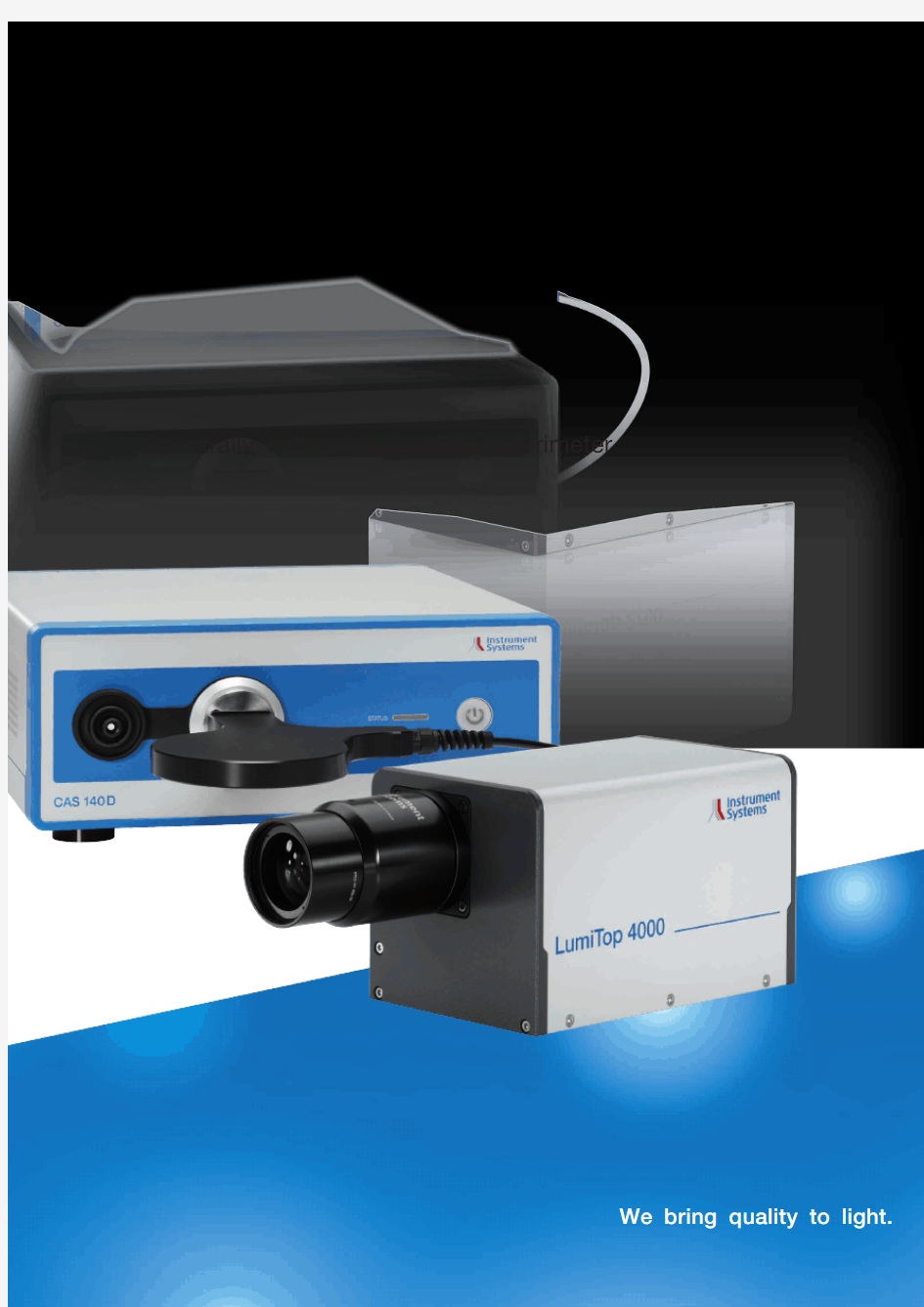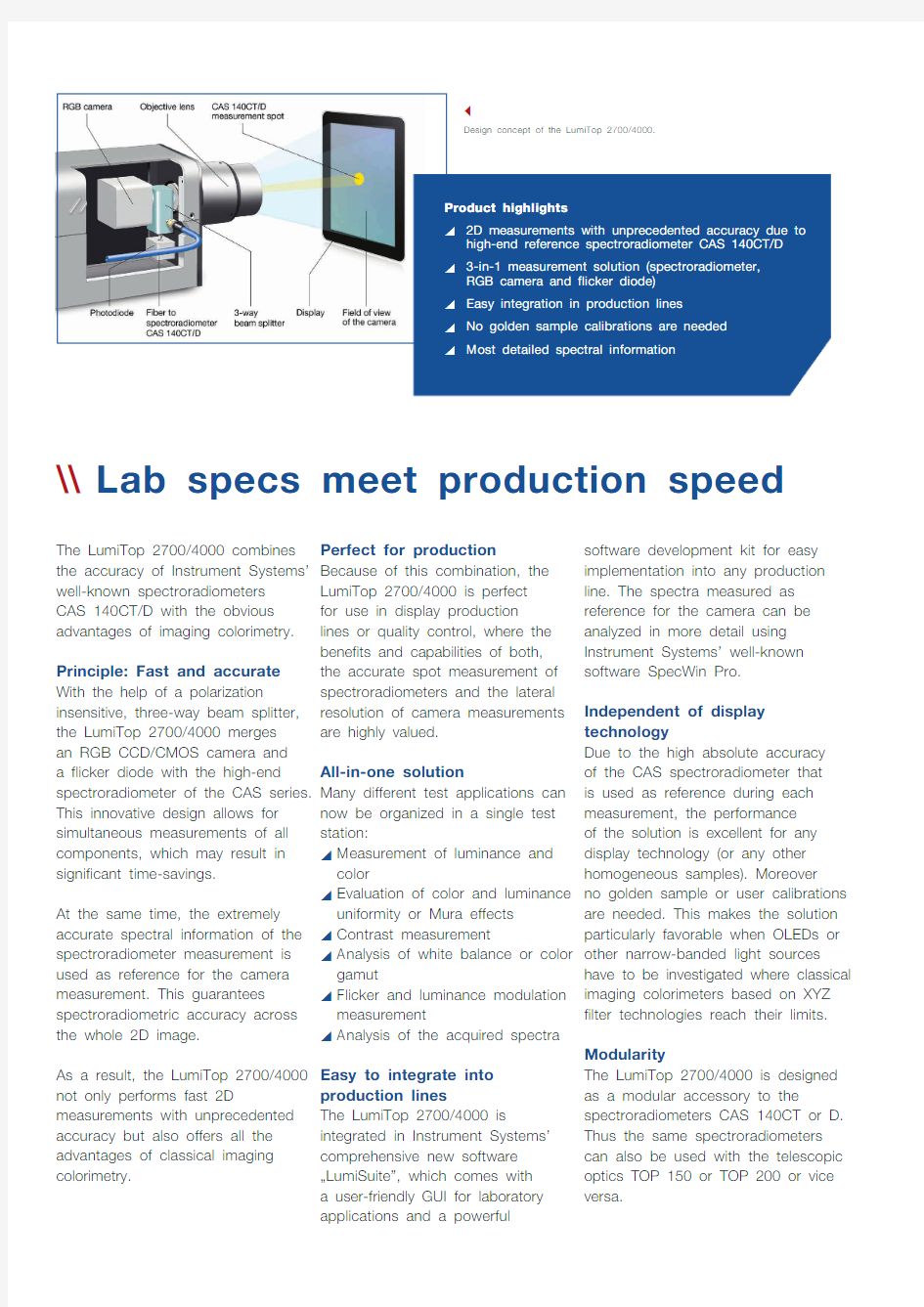lumitop2700_4000_e-9a910016u6


LumiTop 2700/4000 Spectrally enhanced imaging colorimeter
\\ L ab specs meet production speed
The LumiTop 2700/4000 combines the accuracy of Instrument Systems’ well-known spectroradiometers CAS 140CT/D with the obvious advantages of imaging colorimetry. Principle: Fast and accurate With the help of a polarization insensitive, three-way beam splitter, the LumiTop 2700/4000 merges
an RGB CCD/CMOS camera and
a flicker diode with the high-end spectroradiometer of the CAS series. This innovative design allows for simultaneous measurements of all components, which may result in significant time-savings.
At the same time, the extremely accurate spectral information of the spectroradiometer measurement is used as reference for the camera measurement. This guarantees spectroradiometric accuracy across the whole 2D image.
As a result, the LumiTop 2700/4000 not only performs fast 2D measurements with unprecedented accuracy but also offers all the advantages of classical imaging colorimetry. Perfect for production
Because of this combination, the
LumiTop 2700/4000 is perfect
for use in display production
lines or quality control, where the
benefits and capabilities of both,
the accurate spot measurement of
spectroradiometers and the lateral
resolution of camera measurements
are highly valued.
All-in-one solution
Many different test applications can
now be organized in a single test
station:
y M easurement of luminance and
color
y E valuation of color and luminance
uniformity or Mura effects
y C ontrast measurement
y A nalysis of white balance or color
gamut
y F licker and luminance modulation
measurement
y A nalysis of the acquired spectra
Easy to integrate into
production lines
The LumiTop 2700/4000 is
integrated in Instrument Systems’
comprehensive new software
…LumiSuite”, which comes with
a user-friendly GUI for laboratory
applications and a powerful
software development kit for easy
implementation into any production
line. The spectra measured as
reference for the camera can be
analyzed in more detail using
Instrument Systems’ well-known
software SpecWin Pro.
Independent of display
technology
Due to the high absolute accuracy
of the CAS spectroradiometer that
is used as reference during each
measurement, the performance
of the solution is excellent for any
display technology (or any other
homogeneous samples). Moreover
no golden sample or user calibrations
are needed. This makes the solution
particularly favorable when OLEDs or
other narrow-banded light sources
have to be investigated where classical
imaging colorimeters based on XYZ
filter technologies reach their limits.
Modularity
The LumiTop 2700/4000 is designed
as a modular accessory to the
spectroradiometers CAS 140CT or D.
Thus the same spectroradiometers
can also be used with the telescopic
optics TOP 150 or TOP 200 or vice
versa.
1)Inclusive lens and fiber exit.
2)Without CAS, with mode mixer.
3)E xternal neutral density filters on the lens (OD 0.3/0.6/0.9) are available for increasing
the upper measurement limit or measuring modulated light sources.
4)L ower measurement limit based on a signal to noise ratio of 10:1 for maximum
exposure time (60 seconds LumiTop 2700 / 10 seconds LumiTop 4000). Upper
measurement limit based on a signal level < 80 % for a white (non-modulated) LED light source using for minimum exposure time (1 ms LumiTop 2700 / 27 μs LumiTop 4000).
5)T ypical value for maximum deviation over the FOV relative to the CAS spot;
calculated for an image with 16 pixels (LumiTop 2700) / 21 pixels (LumiTop 4000) cropped at each edge and 10 by 10 pixels (LumiTop 2700) / 13 by 13 pixels
(LumiTop 4000) binning (34 averages) immediately after calibration with reference used for flat-field correction.
6)2σ of repeated measurements of one instrument (white LED, L ≈ 100 cd/m2,
autoexposure).
7)R NU (response non-uniformity) is defined as 99.7 % percentile of the deviation
of the mean image value; calculated for an image with 16 pixels (LumiTop 2700) /
21 pixels (LumiTop 4000) cropped at each edge and 10 by 10 pixels (LumiTop 2700) /
13 by 13 pixels (LumiTop 4000) binning (34 averages) immediately after calibration
with reference used for flat-field correction.
8)T ime between beginning of two subsequent measurements using the SDK;
determined with a camera exposure time of 20 ms and CAS exposure time of
200 ms for a white LED (L ≈ 500 cd/m2). Depends mainly on PC processing
capability.
9)L ower measurement limit based on a signal to noise ratio of 10:1 for maximum exposure
time of 65 s. Upper measurement limit based on a signal level < 80 % for a white (non-modulated) LED light source using an optical density filter OD4 and minimum exposure time (10 ms CAS 140CT / 4 ms CAS 140D). Values valid for CAS 140CT with 100 μm and CAS 140D with 250 μm slit width.
10)I mmediately after calibration relative to calibration standard.
11)I mmediately after calibration.
12)M aximum deviation from average of repeated CAS measurements with a linear
polarized light source and varying polarization angle.
13)L ≈ 150 cd/m2, 30 Hz, 10 % sine wave.
14)2σ of repeated measurements of one instrument.
15)Distance between DUT and front plate of LumiTop.
\\T
echnical specifications
Instrument Systems GmbH Kastenbauerstr. 2
81677 Munich, Germany ph: +49 (0)89 45 49 43-58 fax: +49 (0)89 45 49 43-11 info@https://www.360docs.net/doc/6e4983128.html, https://www.360docs.net/doc/6e4983128.html, b _ L u m i T o p _ e n _ V 1 .
3
Instrument Systems is continually working on the further development of its products. Technical changes, errors and misprints do not justify claims for damages. For all other purposes, our Terms and Conditions of Business shall be applicable.
We bring quality to light.
